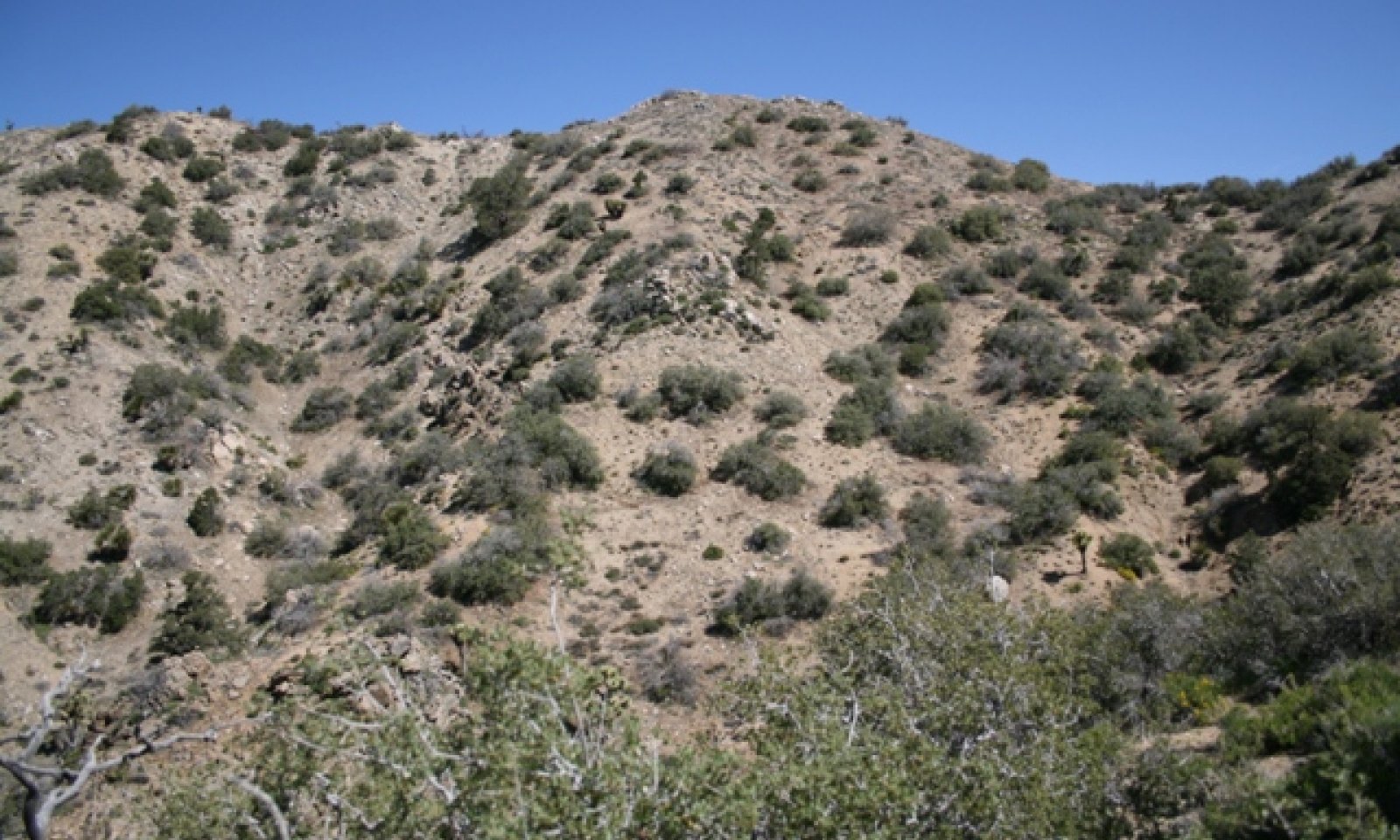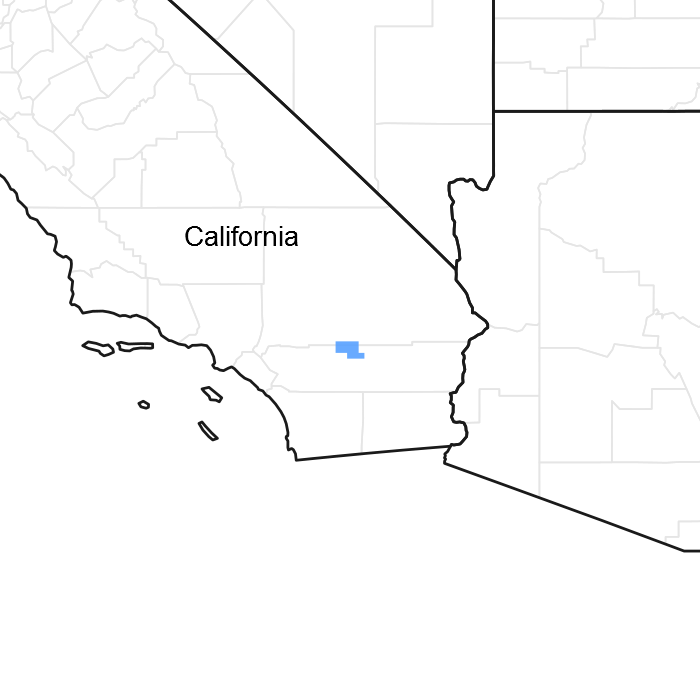

Natural Resources
Conservation Service
Ecological site R030XE191CA
Dry Sandy Mountain Slopes
Last updated: 10/21/2024
Accessed: 12/22/2025
General information
Provisional. A provisional ecological site description has undergone quality control and quality assurance review. It contains a working state and transition model and enough information to identify the ecological site.

Figure 1. Mapped extent
Areas shown in blue indicate the maximum mapped extent of this ecological site. Other ecological sites likely occur within the highlighted areas. It is also possible for this ecological site to occur outside of highlighted areas if detailed soil survey has not been completed or recently updated.
MLRA notes
Major Land Resource Area (MLRA): 030X–Mojave Basin and Range
MLRA Description:
Major Land Resource Area (MLRA) 30, Mojave Desert, is found in southern California, southern Nevada, the extreme southwest corner of Utah and northwestern Arizona within the Basin and Range Province of the Intermontane Plateaus. The climate of the area is hot (primarily hyperthermic and thermic; however at higher elevations, generally above 5000 feet, mesic, cryic and frigid) and dry (aridic). Elevations range from below sea level to over 12,000 feet in the higher mountain areas found within the MLRA. Due to the extreme elevational range found within this MLRA, Land Resource Units (LRUs) were designated to group the MLRA into similar land units.
LRU notes
This LRU (designated by ’XE’) is found only in California at the transition zone between MLRA 20, the Southern California Mountains, and MLRA 30. Elevations range from 3500 to 5800 feet and precipitation ranges from 8 to 12 inches per year. The LRU is characterized primarily by cool thermic and mesic soil temperature regimes and aridic bordering on xeric soil moisture regimes. Precipitation is mostly winter, receiving approximately 85% between October and February, going from rain in the fall to snow into the winter. Snow can range from between 1 and 6 inches. Soils show indications of greater moisture storage with some mollic colors in the soil profile. Vegetation is highly productive and vigorous for the Mojave Desert and includes non-typical Mojave species such as, scrub oaks, manzanita, sumac, ziziphus, mountain mahogany, presence of singleleaf pinyon, and desert needlegrass.
Classification relationships
Pinus monophylla Woodland Alliance (Sawyer et al. 2009).
Ecological site concept
This site occurs on steep mountain slopes at elevations of 3400 to 5800 feet. Soils are very shallow and shallow and have a xeric bordering on aridic soil moisture regime. The site is associated with dry landscape positions that do not support high tree or shrub cover relative to cooler and/or moister topographic positions. Single-leaf pinyon pine (Pinus monophylla) and Muller’s oak (Quercus cornelius-mulleri) dominate this site, with a sparse understory of perennial grasses, subshrubs and secondary shrubs. Sparse vegetation cover results in increased soil erosion on these steep slopes, which causes a feedback that maintains low cover.
Data ranges in the physiographic data, climate data, water features, and soil data sections of this Ecological Site Description are based on major components only (15 percent of map unit or greater).
This site is part of group provisional concept R030XE196CA.
Associated sites
| R030XB189CA |
Shallow Cool Hills R030XB189CA occurs on adjacent cool thermic slopes with a typic aridic soil moisture regime. Blackbrush (Coleogyne ramosissima) and California juniper (Juniperus californica) dominate. |
|---|---|
| R030XB172CA |
Warm Gravelly Shallow Hills R030XB172CA is found on adjacent warmer slopes with a high percentage of large surface rock fragments. Creosote bush (Larrea tridentata) and Parish's goldeneye (Vigueira parishii) are dominant. |
| R030XB213CA |
Moderately Deep Gravelly Mountain Slopes R030XB213CA is found on adjacent slopes with a typic aridic soil moisture regime and moderately deep, skeletal soils. Eastern mojave buckwheat (Eriogonum fasciculatum), desert needlegrass (Achnatherum speciosum) and California juniper (Juniperus californica) are dominant species. |
| R030XD040CA |
Hyperthermic Steep North Slopes R030XD040CA is found on adjacent hyperthermic slopes. Burrobush (Ambrosia dumosa), brittlebush (Encelia farinosa) and creosote bush (Larrea tridentata) are dominant species. |
| R030XE196CA |
Sandy Xeric-Intergrade Slopes R030XE196CA occurs on adjacent cooler and moister landform positions, often north-facing slopes. Single-leaf pinyon pine (Pinus monophylla), California juniper (Juniperus californica) and Muller's oak (Quercus turbinella) are dominants, with a high diversity of understory shrub species. |
| R030XY202CA |
Very Rarely To Rarely Flooded Thermic Ephemeral Stream R030XY202CA is found on adjacent small, rarely flooded ephemeral drainageways. California jointfir (Ephedra californica) and burrobrush (Hymenoclea salsola) dominate, but a productive and diverse assemblage of shrubs is present. |
Similar sites
| R030XE196CA |
Sandy Xeric-Intergrade Slopes R030XE196CA is found on more cooler and moister landform positions and has higher shrub diversity and cover. |
|---|---|
| R030XB213CA |
Moderately Deep Gravelly Mountain Slopes R030XB213CA is found on slopes with a typic aridic soil moisture regime and moderately deep skeletal soils. Eastern mojave buckweat (Eriogonum fasciculatum) and desert needlegrass (Achnatherum speciosum) are dominants with California juniper (Juniperus callifornica). Single-leaf pinyon pine (Pinus monophylla) is trace if present. |
| R030XE200CA |
Xeric Very Deep Sandy Fan Aprons On Pediments R030XE200CA occurs on pediments and low hills and blackbrush (Coleogyne ramosissima) is an important species. |
| R030XA178CA |
Moderately Deep Sandy Slopes R030XA178CA is found on moderately deep soils and has greater shrub diversity. Parry's jujube (Ziziphus parryi) is an important species. |
Table 1. Dominant plant species
| Tree |
(1) Quercus cornelius-mulleri |
|---|---|
| Shrub |
Not specified |
| Herbaceous |
Not specified |
Click on box and path labels to scroll to the respective text.

